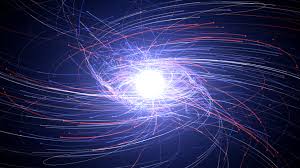Antimatter:

An international collaboration of scientists based in Europe reported that they had, for the first time, observed that the matter and antimatter versions of a type of subatomic particle called a baryon decay at different rates.
- Antimatter is the same as ordinary matter except that it has the opposite electric charge.
- The antimatter particles corresponding to electrons, protons, and neutrons are called positrons (e+), antiprotons (p), and antineutrons (n); collectively they are referred to as antiparticles.
- The electrical properties of antimatter being opposite to those of ordinary matter, the positron has a positive charge and the antiproton a negative charge; the antineutron, though electrically neutral, has a magnetic moment opposite in sign to that of the neutron.
- Matter and antimatter cannot coexist at close range for more than a small fraction of a second because they collide with and annihilate each other, releasing large quantities of energy in the form of gamma rays or elementary particles.
- Antimatter was created along with matter after the Big Bang. But antimatter is rare in today’s universe.
- Humans have created antimatter particles using ultra-high-speed collisions at huge particle accelerators such as the Large Hadron Collider, which is located outside Geneva and operated by CERN (the European Organization for Nuclear Research).




